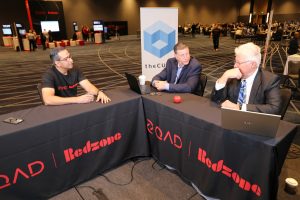 AI
AI
 AI
AI
 AI
AI
With tightening labor markets and ongoing supply chain volatility, manufacturers are adopting artificial intelligence to enhance the capacity of their existing workforce rather than reduce headcount. The new standard for AI in manufacturing is clear: automate routine tasks, elevate human judgment and redesign systems to support decision-making instead of data entry.
In this vision for the sector’s future, AI is focused less on fully automated plants and more on empowering operators. In essence, AI is becoming an exoskeleton for expertise, amplifying the impact of every skilled worker, according to Sanjay Brahmawar (pictured), chief executive officer of QAD Inc.

QAD’s Sanjay Brahmawar talks with theCUBE about how AI in manufacturing can boost capacity, empower workers and turn ERP into systems of action
“When you apply agent AI and you apply these capabilities, you are allowing these people, these qualified professionals, to actually use their powers on the right things,” Brahmawar explained. “It’s almost literally [like] we are supercharging these people.”
Brahmawar spoke with Scott Hebner, principal analyst at theCUBE Research, and Paul Gillin, enterprise editor at SiliconANGLE, at the QAD Champions of Manufacturing event, during an exclusive broadcast on theCUBE, SiliconANGLE Media’s livestreaming studio. They discussed the current state of the industry and how AI-powered factory operations seeks to redefine the manufacturing sector. (* Disclosure below.)
The manufacturing labor crunch now defines the strategic context for every investment decision. With experienced talent hard to find and younger workers skeptical of dated systems, AI is being positioned as both a capacity lever and a recruitment tool, making the shop floor look and feel more like the digital tools new entrants use everywhere else, according to Brahmawar. Against that backdrop, AI agents are framed less as a threat to jobs and more as a way to keep production running at all, especially amid continued supply chain disruptions.
“The reality is that we’ve got 500,000 open jobs in the U.S. today. There is a capacity shortfall in manufacturing and this is not going to get any better … by 2033, it’s gonna be 2 million open jobs,” he said. “The way we look at it is that [we] look at two things. One, the people that are in manufacturing today, we’ve gotta empower them and we’ve gotta make them more effective, because that is one way to address this capacity shortfall. The second thing is we’ve gotta change the systems to become systems of action, because we want to attract the next generation talent and you’re not gonna attract these next generation talent with these green screens and old systems.”
For technology providers, this perspective shift reframes AI from back-office optimization to a front-line productivity engine. Plants are looking to squeeze more output from fixed footprints and finite skills, using AI in manufacturing to stretch existing teams rather than expand them. But the real test is whether AI can unlock step-changes in production with the same people and assets, Brahmawar noted.
“If you can get a 26% productivity improvement, you can get the output of four lines in the cost of three,” he explained. “It’s not that our clients are not conscious about costs. They are very conscious about costs, but you [have to] look at it the other way. I’ve got the same people and I can do another production line … That’s the way our clients are looking at it. And every agent that we have created and that we are exposing to our clients today has that thinking in ‘What is the problem we are trying to solve? And what is the real impact or material impact to us — to our client’s operation?’”
Here’s the complete video interview, part of SiliconANGLE’s and theCUBE’s coverage of QAD Champions of Manufacturing event:
(* Disclosure: TheCUBE is a paid media partner for the QAD Champions of Manufacturing event. Neither QAD, the sponsor of theCUBE’s event coverage, nor other sponsors have editorial control over content on theCUBE or SiliconANGLE.)
Support our mission to keep content open and free by engaging with theCUBE community. Join theCUBE’s Alumni Trust Network, where technology leaders connect, share intelligence and create opportunities.
Founded by tech visionaries John Furrier and Dave Vellante, SiliconANGLE Media has built a dynamic ecosystem of industry-leading digital media brands that reach 15+ million elite tech professionals. Our new proprietary theCUBE AI Video Cloud is breaking ground in audience interaction, leveraging theCUBEai.com neural network to help technology companies make data-driven decisions and stay at the forefront of industry conversations.